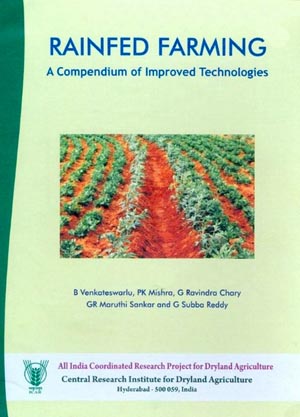Preface

In view of the slow down of productivity growth in irrigated agriculture, there is an urgent need to enhance the contribution of rainfed farming to the national food basket. For many years, its contribution has remained around 40-45%, which needs to be enhanced, if the objectives of growth with equity have to be met. Enhanced productivity leading to better incomes is the only way to improve the livelihoods of small and marginal farmers in rainfed areas. For the country also, there is an urgent need for enhancing the production of pulses and oilseeds, which are predominantly grown in rainfed areas to meet the domestic shortfall.
Rainfed areas have diverse farming systems, different potentials and constraints, which can only be addressed through development and application of location specific technologies. The All India Coordinated Research Project for Dryland Agriculture (AICRPDA) has carried out location specific, adaptive research in a network mode which resulted in development of improved technologies in the areas of rainfed cropping systems, drought management, rainwater conservation, nutrient management and farm mechanization. Some of these technologies have already formed part of the package of practices for crops in different States. However, in view of the increasing importance of rainfed agriculture and the need for boosting productivity, information on the potential of improved technologies and possible means of upscaling has to be made available to a wide spectrum of stakeholders like technical and administrative personnel of Central and State ministries dealing with dryland farming, extension officers, NGOs and farmers. Towards this objective, we have decided to compile the most promising technologies in the above thrust areas, which can increase production, decrease cost of cultivation, reduce drudgery and enable farmers to complete farm operations timely, which is the essence of dryland agriculture.
I compliment Dr.P. K. Mishra, Project Coordinator (Dryland Research), Dr. G. Ravindra Chary, Dr. G.R. Maruthi Sankar, Dr.G. Subba Reddy (former Project Coordinator, Dryland Research) and all the contributing scientists for their effort in compiling this publication. In order to accommodate more number of technologies from diverse agroclimatic regions, only a brief of the technology profile is given in this book. More details on the actual technology can be obtained from the respective chief scientists in the State Agricultural Universities. I hope this publication will be quite useful to all the stakeholders mentioned above. The direct and indirect contributions from all those including farmers involved in developing, testing, demonstrations and popularizing these technologies are duly acknowledged.
(B. Venkateswarlu)
Published by
Director,
Central Research Institute for Dryland Agriculture (ICAR),
Santoshnagar, Hyderabad 500 059, Andhra Pradesh, India.
Phone: +91-040-24530177 / 24530828 (O)
Fax: +91-040-24531802 / 24530828
Website: http://crida.ernet.in








Like on Facebook
Subscribe on Youtube
Follow on X X
Like on instagram